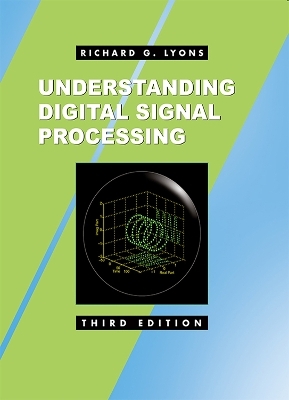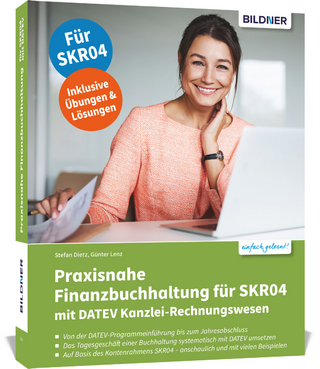
Understanding Digital Signal Processing
Pearson (Verlag)
978-0-13-702741-5 (ISBN)
Understanding Digital Signal Processing, Third Edition, is quite simply the best resource for engineers and other technical professionals who want to master and apply today’s latest DSP techniques. Richard G. Lyons has updated and expanded his best-selling second edition to reflect the newest technologies, building on the exceptionally readable coverage that made it the favorite of DSP professionals worldwide. He has also added hands-on problems to every chapter, giving students even more of the practical experience they need to succeed.
Comprehensive in scope and clear in approach, this book achieves the perfect balance between theory and practice, keeps math at a tolerable level, and makes DSP exceptionally accessible to beginners without ever oversimplifying it. Readers can thoroughly grasp the basics and quickly move on to more sophisticated techniques.
This edition adds extensive new coverage of FIR and IIR filter analysis techniques, digital differentiators, integrators, and matched filters. Lyons has significantly updated and expanded his discussions of multirate processing techniques, which are crucial to modern wireless and satellite communications. He also presents nearly twice as many DSP Tricks as in the second edition—including techniques even seasoned DSP professionals may have overlooked.
Coverage includes
New homework problems that deepen your understanding and help you apply what you’ve learned
Practical, day-to-day DSP implementations and problem-solving throughout
Useful new guidance on generalized digital networks, including discrete differentiators, integrators, and matched filters
Clear descriptions of statistical measures of signals, variance reduction by averaging, and real-world signal-to-noise ratio (SNR) computation
A significantly expanded chapter on sample rate conversion (multirate systems) and associated filtering techniques
New guidance on implementing fast convolution, IIR filter scaling, and more
Enhanced coverage of analyzing digital filter behavior and performance for diverse communications and biomedical applications
Discrete sequences/systems, periodic sampling, DFT, FFT, finite/infinite impulse response filters, quadrature (I/Q) processing, discrete Hilbert transforms, binary number formats, and much more
Richard G. Lyons is a consulting Systems Engineer and lecturer with Besser Associates in Mountain View, California. He is author of the book "Understanding Digital Signal Processing", editor and contributor to the book "Streamlining Digital Signal Processing", and has authored numerous articles on DSP. Lyons has taught DSP at the University of California Santa Cruz Extension and recently received the IEEE Signal Processing Society's 2012 Educator of the Year award.
Preface xv About the Author xxiii
Chapter 1: Discrete Sequences and Systems 1
1.1 Discrete Sequences and their Notation 2
1.2 Signal Amplitude, Magnitude, Power 8
1.3 Signal Processing Operational Symbols 10
1.4 Introduction to Discrete Linear Time-Invariant Systems 12
1.5 Discrete Linear Systems 12
1.6 Time-Invariant Systems 17
1.7 The Commutative Property of Linear Time-Invariant Systems 18
1.8 Analyzing Linear Time-Invariant Systems 19
References 21
Chapter 1 Problems 23
Chapter 2: Periodic Sampling 33
2.1 Aliasing: Signal Ambiguity in the Frequency Domain 33
2.2 Sampling Lowpass Signals 38
2.3 Sampling Bandpass Signals 42
2.4 Practical Aspects of Bandpass Sampling 45
References 49
Chapter 2 Problems 50
Chapter 3: The Discrete Fourier Transform 59
3.1 Understanding the DFT Equation 60
3.2 DFT Symmetry 73
3.3 DFT Linearity 75
3.4 DFT Magnitudes 75
3.5 DFT Frequency Axis 77
3.6 DFT Shifting Theorem 77
3.7 Inverse DFT 80
3.8 DFT Leakage 81
3.9 Windows 89
3.10 DFT Scalloping Loss 96
3.11 DFT Resolution, Zero Padding, and Frequency-Domain Sampling 98
3.12 DFT Processing Gain 102
3.13 The DFT of Rectangular Functions 105
3.14 Interpreting the DFT Using the Discrete-Time Fourier Transform 120
References 124
Chapter 3 Problems 125
Chapter 4: The Fast Fourier Transform 135
4.1 Relationship of the FFT to the DFT 136
4.2 Hints on Using FFTs in Practice 137
4.3 Derivation of the Radix-2 FFT Algorithm 141
4.4 FFT Input/Output Data Index Bit Reversal 149
4.5 Radix-2 FFT Butterfly Structures 151
4.6 Alternate Single-Butterfly Structures 154
References 158
Chapter 4 Problems 160
Chapter 5: Finite Impulse Response Filters 169
5.1 An Introduction to Finite Impulse Response (FIR) Filters 170
5.2 Convolution in FIR Filters 175
5.3 Lowpass FIR Filter Design 186
5.4 Bandpass FIR Filter Design 201
5.5 Highpass FIR Filter Design 203
5.6 Parks-McClellan Exchange FIR Filter Design Method 204
5.7 Half-band FIR Filters 207
5.8 Phase Response of FIR Filters 209
5.9 A Generic Description of Discrete Convolution 214
5.10 Analyzing FIR Filters 226
References 235
Chapter 5 Problems 238
Chapter 6: Infinite Impulse Response Filters 253
6.1 An Introduction to Infinite Impulse Response Filters 254
6.2 The Laplace Transform 257
6.3 The z-Transform 270
6.4 Using the z-Transform to Analyze IIR Filters 274
6.5 Using Poles and Zeros to Analyze IIR Filters 282
6.6 Alternate IIR Filter Structures 289
6.7 Pitfalls in Building IIR Filters 292
6.8 Improving IIR Filters with Cascaded Structures 295
6.9 Scaling the Gain of IIR Filters 300
6.10 Impulse Invariance IIR Filter Design Method 303
6.11 Bilinear Transform IIR Filter Design Method 319
6.12 Optimized IIR Filter Design Method 330
6.13 A Brief Comparison of IIR and FIR Filters 332
References 333
Chapter 6 Problems 336
Chapter 7: Specialized Digital Networks and Filters 361
7.1 Differentiators 361
7.2 Integrators 370
7.3 Matched Filters 376
7.4 Interpolated Lowpass FIR Filters 381
7.5 Frequency Sampling Filters: The Lost Art 392
References 426
Chapter 7 Problems 429
Chapter 8: Quadrature Signals 439
8.1 Why Care about Quadrature Signals? 440
8.2 The Notation of Complex Numbers 440
8.3 Representing Real Signals Using Complex Phasors 446
8.4 A Few Thoughts on Negative Frequency 450
8.5 Quadrature Signals in the Frequency Domain 451
8.6 Bandpass Quadrature Signals in the Frequency Domain 454
8.7 Complex Down-Conversion 456
8.8 A Complex Down-Conversion Example 458
8.9 An Alternate Down-Conversion Method 462
References 464
Chapter 8 Problems 465
Chapter 9: The Discrete Hilbert Transform 479
9.1 Hilbert Transform Definition 480
9.2 Why Care about the Hilbert Transform? 482
9.3 Impulse Response of a Hilbert Transformer 487
9.4 Designing a Discrete Hilbert Transformer 489
9.5 Time-Domain Analytic Signal Generation 495
9.6 Comparing Analytical Signal Generation Methods 497
References 498
Chapter 9 Problems 499
Chapter 10: Sample Rate Conversion 507
10.1 Decimation 508
10.2 Two-Stage Decimation 510
10.3 Properties of Downsampling 514
10.4 Interpolation 516
10.5 Properties of Interpolation 518
10.6 Combining Decimation and Interpolation 521
10.7 Polyphase Filters 522
10.8 Two-Stage Interpolation 528
10.9 z-Transform Analysis of Multirate Systems 533
10.10 Polyphase Filter Implementations 535
10.11 Sample Rate Conversion by Rational Factors 540
10.12 Sample Rate Conversion with Half-band Filters 543
10.13 Sample Rate Conversion with IFIR Filters 548
10.14 Cascaded Integrator-Comb Filters 550
References 566
Chapter 10 Problems 568
Chapter 11: Signal Averaging 589
11.1 Coherent Averaging 590
11.2 Incoherent Averaging 597
11.3 Averaging Multiple Fast Fourier Transforms 600
11.4 Averaging Phase Angles 603
11.5 Filtering Aspects of Time-Domain Averaging 604
11.6 Exponential Averaging 608
References 615
Chapter 11 Problems 617
Chapter 12: Digital Data Formats and their Effects 623
12.1 Fixed-Point Binary Formats 623
12.2 Binary Number Precision and Dynamic Range 632
12.3 Effects of Finite Fixed-Point Binary Word Length 634
12.4 Floating-Point Binary Formats 652
12.5 Block Floating-Point Binary Format 658
References 658
Chapter 12 Problems 661
Chapter 13: Digital Signal Processing Tricks 671
13.1 Frequency Translation without Multiplication 671
13.2 High-Speed Vector Magnitude Approximation 679
13.3 Frequency-Domain Windowing 683
13.4 Fast Multiplication of Complex Numbers 686
13.5 Efficiently Performing the FFT of Real Sequences 687
13.6 Computing the Inverse FFT Using the Forward FFT 699
13.7 Simplified FIR Filter Structure 702
13.8 Reducing A/D Converter Quantization Noise 704
13.9 A/D Converter Testing Techniques 709
13.10 Fast FIR Filtering Using the FFT 716
13.11 Generating Normally Distributed Random Data 722
13.12 Zero-Phase Filtering 725
13.13 Sharpened FIR Filters 726
13.14 Interpolating a Bandpass Signal 728
13.15 Spectral Peak Location Algorithm 730
13.16 Computing FFT Twiddle Factors 734
13.17 Single Tone Detection 737
13.18 The Sliding DFT 741
13.19 The Zoom FFT 749
13.20 A Practical Spectrum Analyzer 753
13.21 An Efficient Arctangent Approximation 756
13.22 Frequency Demodulation Algorithms 758
13.23 DC Removal 761
13.24 Improving Traditional CIC Filters 765
13.25 Smoothing Impulsive Noise 770
13.26 Efficient Polynomial Evaluation 772
13.27 Designing Very High-Order FIR Filters 775
13.28 Time-Domain Interpolation Using the FFT 778
13.29 Frequency Translation Using Decimation 781
13.30 Automatic Gain Control (AGC) 783
13.31 Approximate Envelope Detection 784
13.32 AQuadrature Oscillator 786
13.33 Specialized Exponential Averaging 789
13.34 Filtering Narrowband Noise Using Filter Nulls 792
13.35 Efficient Computation of Signal Variance 797
13.36 Real-time Computation of Signal Averages and Variances 799
13.37 Building Hilbert Transformers from Half-band Filters 802
13.38 Complex Vector Rotation with Arctangents 805
13.39 An Efficient Differentiating Network 810
13.40 Linear-Phase DC-Removal Filter 812
13.41 Avoiding Overflow in Magnitude Computations 815
13.42 Efficient Linear Interpolation 815
13.43 Alternate Complex Down-conversion Schemes 816
13.44 Signal Transition Detection 820
13.45 Spectral Flipping around Signal Center Frequency 821
13.46 Computing Missing Signal Samples 823
13.47 Computing Large DFTs Using Small FFTs 826
13.48 Computing Filter Group Delay without Arctangents 830
13.49 Computing a Forward and Inverse FFT Using a Single FFT 831
13.50 Improved Narrowband Lowpass IIR Filters 833
13.51 A Stable Goertzel Algorithm 838
References 840
Appendix A: The Arithmetic of Complex Numbers 847
A.1 Graphical Representation of Real and Complex Numbers 847
A.2 Arithmetic Representation of Complex Numbers 848
A.3 Arithmetic Operations of Complex Numbers 850
A.4 Some Practical Implications of Using Complex Numbers 856
Appendix B: Closed Form of a Geometric Series 859
Appendix C: Time Reversal and the DFT 863
Appendix D: Mean, Variance, and Standard Deviation 867
D.1 Statistical Measures 867
D.2 Statistics of Short Sequences 870
D.3 Statistics of Summed Sequences 872
D.4 Standard Deviation (RMS) of a Continuous Sinewave 874
D.5 Estimating Signal-to-Noise Ratios 875
D.6 The Mean and Variance of Random Functions 879
D.7 The Normal Probability Density Function 882
Appendix E: Decibels (DB and DBM) 885
E.1 Using Logarithms to Determine Relative Signal Power 885
E.2 Some Useful Decibel Numbers 889
E.3 Absolute Power Using Decibels 891
Appendix F: Digital Filter Terminology 893
Appendix G: Frequency Sampling Filter Derivations 903
G.1 Frequency Response of a Comb Filter 903
G.2 Single Complex FSF Frequency Response 904
G.3 Multisection Complex FSF Phase 905
G.4 Multisection Complex FSF Frequency Response 906
G.5 Real FSF Transfer Function 908
G.6 Type-IV FSF Frequency Response 910
Appendix H: Frequency Sampling Filter Design Tables 913
Appendix I: Computing Chebyshev Window Sequences 927
I.1 Chebyshev Windows for FIR Filter Design 927
I.2 Chebyshev Windows for Spectrum Analysis 929
Index 931
| Erscheint lt. Verlag | 11.11.2010 |
|---|---|
| Sprache | englisch |
| Maße | 186 x 239 mm |
| Gewicht | 1700 g |
| Themenwelt | Mathematik / Informatik ► Informatik |
| ISBN-10 | 0-13-702741-9 / 0137027419 |
| ISBN-13 | 978-0-13-702741-5 / 9780137027415 |
| Zustand | Neuware |
| Haben Sie eine Frage zum Produkt? |
aus dem Bereich


